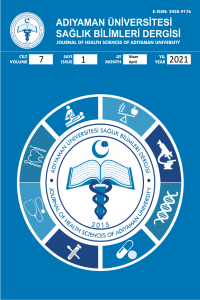PERİANAL SİNÜS TEDAVİSİNDE PRESS-FİT® (DOĞAL KOLLAJEN PLUG) UYGULAMASI
Pilonidal sinus, collagen plaque, perianal sinus
Press-Fit® (Natural Collagen Plug) Application in Perianal Sinus Treatmen
Pilonidal sinus, collagen plaque, perianal sinus,
___
- 1. Karydakis GE. Easy and successful treatment of pilonidal sinus after explanation of its causative process. Aust N Z J Surg 1992; 62: 385-389.
- 2. Kanat BH, Bozan MB, Yazar FM, Yur M, Erol F, Özkan Z, Emir S, Urfalıoğlu A. Comparison of early surgery (unroofing-curettage) and elective surgery (Karydakis flap technique) in pilonidal sinus abscess cases. Ulus Travma Acil Cerrahi Derg 2014; 20: 366-370
- 3. Kanat BH, Sözen S. Disease that should be remembered: Sacrococcygeal pilonidal sinus disease and short history. World J Clin Cases 2015; 3(10): 876-879.
- 4. Maurice BA, Greenwood RK. A conservative treatment of pilonidal sinus. Br J Surg 1964; 51: 510-512.
- 5. Demirel AH, Kuşdemir A, Kaptanoğlu B, Barlas M, Bayram E. A Pilonidal Sinus of the Anal Canal (Case Report) The Medical Journal of Kocatepe (2003), 1, 63-66
- 6. Testini M, Miniello S, Di Venere B, Lissidini G, Esposito E. Perineal pilonidal sinus. Case report. Ann Ital Chir. 2002 May-Jun;73(3):339-41.
- 7. King ES. The intedigital pilonidal sinus. Aust N Z J Surg 1949; 19: 29-33.
- 8. Arslan K, Doğru O, Aygen E, Turan E. Non-Operative Management of Pilonidal Sinuses Located Around Anus. Surgical Science, 2012, 3, 588-591.
- 9. Corey W. Iqbal, Alessandra C. Gasior, and Charles L. Snyder, “Pilonidal Disease Mimicking Fistula-in-Ano in a 15-Year-Old Female,” Case Reports in Surgery, vol. 2012, Article ID 310187, 3 pages, 2012. doi:10.1155/2012/310187
- 10. Kulaçoğlu H, Dener C, Tumer H, Aktimur R. Total subcutaneous fistulectomy combined with Karydakis flap for sacrococcygeal pilonidal disease with secondary perianal opening. Colorectal Dis. 2006 Feb;8(2):120-3.
- 11. Zeybek N, Duran E, Çoşkun AK, Sinan H, Özerhan İH, Harlak A, Kılbaş Z, Peker Y. What is the best choice of treatment for pilonidal sinus disease with perianal openings? Gülhane Tıp Derg 2014;56: 238-240
- Yayın Aralığı: Yılda 3 Sayı
- Başlangıç: 2015
- Yayıncı: ADIYAMAN ÜNİVERSİTESİ
Abuzer GÜLER, Mevlüt DOĞUKAN, Recai KAYA, Öznur ULUDAĞ, Atilla Tutak, Mehmet Duran
Yaşlanmanın Mitokondriyal Bütünlüğünün Denetlenmesi
Yusuf DÖĞÜŞ, Mehmet Akif ÇÜRÜK
Non-spesifik kas ağrısı olan hastalarda serum vitamin D düzeylerinin yaş ve cinsiyete göre dağılımı.
Semra COŞKUN, Onur KILINÇ, Ayşe ATILGAN ÇELİK, Adem YILDIRIM
Prematüre Bebeklerde Kültürle Kanıtlı Neonatal Sepsisin Klinik ve Laboratuvar Değerlendirmesi
Halil KAZANASMAZ, Hüseyin GÜMÜŞ
PERİANAL SİNÜS TEDAVİSİNDE PRESS-FİT® (DOĞAL KOLLAJEN PLUG) UYGULAMASI
Burhan Hakan KANAT, Ferhat ÇAY, Mustafa GİRGİN, Barış Çağlar KANAT, Yavuz Selim İLHAN, Ali AKSU, Kenan BİNNETOĞLU
İlginç Bir Akut Batın Nedeni: Yabancı Cisme Bağlı Mide Perforasyonu
Nizamettin KUTLUER, Ahmet BOZDAĞ, Pınar GÜNDOĞAN BOZDAĞ, Ali AKSU, Barış GÜLTÜRK
